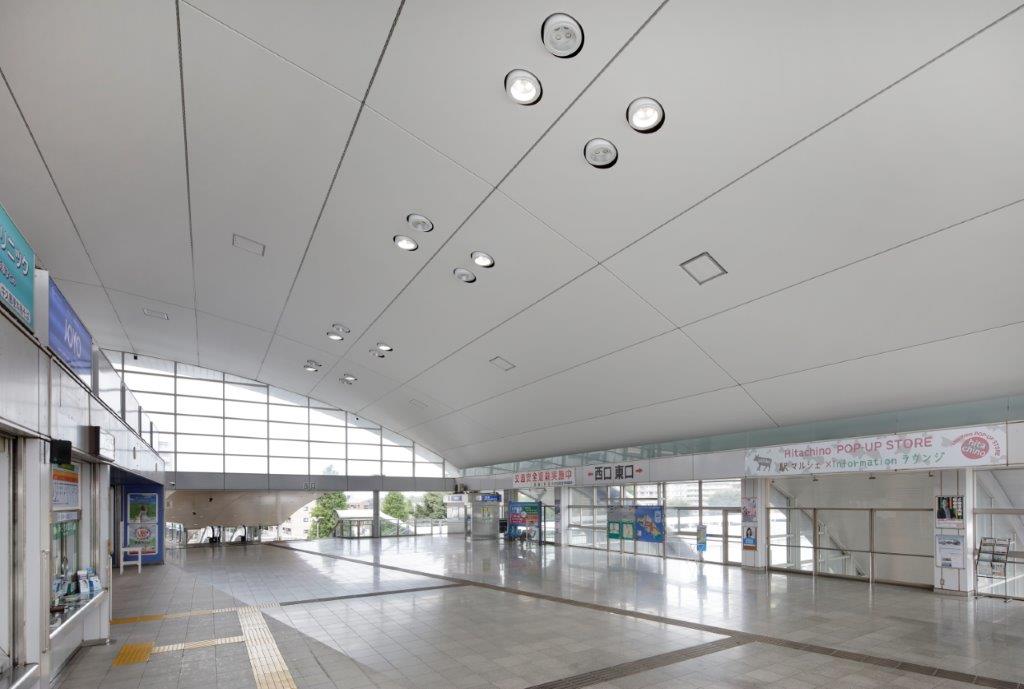

Taiyo Kogyo Column
What ceiling structures utilized in buildings are at risk?
2019.08.09

Certain ceiling structures are often used, especially in large buildings such as commercial facilities like shopping malls and gymnasiums. This section provides an overview of the ceiling structures used in such large facilities, the dangers inherent in them, and their solutions.
Ceiling structures common in large buildings
The ceiling structure often used in large facilities and buildings such as gymnasiums and commercial facilities is called a “suspended ceiling.
In this structure, a grid-like framework is suspended from the back of the ceiling of the structure using metal bolts, etc., and a ceiling board made of plaster, etc., is attached to the surface.
While it has various advantages, there are cases where concerns remain about earthquake resistance, depending on the architectural specifications.
For more information on *suspended ceilings, please see the following article.
What are the advantages and disadvantages of suspended ceilings, which are used in many facilities?
What are the dangers of suspended ceiling structures utilized in large buildings?
Suspended ceilings have the disadvantage that the ceiling itself shakes in response to shaking from earthquakes and other tremors, and the risk of damage or falling remains due to the load placed on certain parts of the ceiling. In the Great East Japan Earthquake, the ceiling boards of suspended ceilings fell in many large facilities such as gymnasiums, causing significant damage one after another. In response to this, in 2014, the government established new standards for suspended ceilings in large facilities with regard to earthquake resistance, requiring a certain level of safety as ” specified ceilings.
*For more information on specific ceilings, please see the following article. The basics of “specified ceilings” are thoroughly explained, and what routes architects should take to keep them in check! If the ceiling of a building falls under the specified ceiling category, whether new or existing, the ceiling structure must be modified or refurbished to meet the newly established safety standards for earthquake countermeasures. The safety of specified ceilings is verified using the following “verification route” set forth by the government.
In order to meet this standard, various proposals for earthquake-resistant ceilings have been developed by companies involved in the construction of ceilings. New products have been developed mainly based on the approaches of “making the ceiling material lighter” and “improving earthquake resistance so that the ceiling will not fall down. For more information on lightweight ceilings, please refer to the following article. What is a lightweight ceiling? A detailed explanation from structure to features ” *For more information on earthquake-resistant ceilings, please refer to the following article. Prevent ceilings from falling out due to earthquakes! However, simply reducing the weight of the ceiling does not avoid the risk of it falling, and increasing earthquake resistance alone will not limit the damage in the event of a fall. Therefore, ” membrane ceilings,” a ceiling structure that boasts a high level of safety in large buildings, are now attracting attention as a solution that combines the merits of both.
Membrane Ceiling" structure is a solution for creating safe ceilings in large facilities.
Membrane ce ilings are a highly safe ceiling structure that does not fall under the category of specified ceilings, even in large spaces.
Membrane ceilings do not fall under the specified ceiling requirements even in large spaces and do not require heavy reinforcement materials, thus providing a high level of safety.
It is light, soft, and strong, and does not require hanging materials.
The ceilings of large buildings such as gymnasiums and commercial facilities, which are used by an unspecified number of people, must have many functions to maintain the comfort of the facility, and even a design that pleases the eyes of the users. There are not many solutions, with the exception of membrane ceilings, that can ensure safety on top of these functions.
When considering the earthquake resistance and safety of ceilings, we recommend that you consider membrane ceilings.

Construction Businessへの
Contact us
Related Articles
- TOP>
- Taiyo Kogyo Column>
- What ceiling structures utilized in buildings are at risk?








